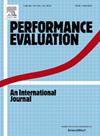Can attacks reduce Age of Information?
IF 0.8
4区 计算机科学
Q4 COMPUTER SCIENCE, HARDWARE & ARCHITECTURE
引用次数: 0
Abstract
We study a monitoring system in which a single source sends status updates to a monitor through a communication channel. The communication channel is modeled as a queueing system, and we assume that attacks occur following a random process. When an attack occurs, all packets in the queueing system are discarded. While one might expect attacks to always negatively impact system performance, we demonstrate in this paper that, from the perspective of Age of Information (AoI), attacks can in some cases reduce the AoI. Our objective is to identify the conditions under which AoI is reduced and to determine the attack rate that minimizes or reduces AoI. First, we analyze single and tandem M/M/1/1 queues with preemption and show that attacks cannot reduce AoI in these cases. Next, we examine a single M/M/1/1 queue without preemption and establish necessary and sufficient conditions for the existence of an attack rate that minimizes AoI. For this scenario, we also derive an upper bound for the optimal attack rate and prove that it becomes tight when the arrival rate of updates is very high. Through numerical experiments, we observe that attacks can reduce AoI in tandem M/M/1/1 queues without preemption, as well as in preemptive M/M/1/2 and M/M/1/3 queues. Furthermore, we show that the benefit of attacks on AoI increases with the buffer size.
攻击能减少信息时代吗?
我们研究了一个监控系统,其中单个源通过通信通道向监视器发送状态更新。通信通道被建模为一个排队系统,我们假设攻击发生在一个随机的过程中。当攻击发生时,队列系统中的所有报文将被丢弃。虽然人们可能期望攻击总是对系统性能产生负面影响,但我们在本文中证明,从信息时代(Age of Information, AoI)的角度来看,攻击在某些情况下可以降低AoI。我们的目标是确定减少AoI的条件,并确定最小化或减少AoI的攻击率。首先,我们分析了具有抢占的单队列和串联M/M/1/1队列,并表明在这些情况下攻击不能降低AoI。接下来,我们研究了一个没有抢占的M/M/1/1队列,并建立了使AoI最小的攻击率存在的充分必要条件。对于这种情况,我们还推导了最优攻击率的上界,并证明当更新到达率非常高时,它会变得很紧。通过数值实验,我们观察到攻击可以减少无抢占的M/M/1/1队列中的AoI,以及抢占的M/M/1/2和M/M/1/3队列中的AoI。此外,我们还表明,攻击AoI的好处随着缓冲区大小的增加而增加。
本文章由计算机程序翻译,如有差异,请以英文原文为准。
求助全文
约1分钟内获得全文
求助全文
来源期刊

Performance Evaluation
工程技术-计算机:理论方法
CiteScore
3.10
自引率
0.00%
发文量
20
审稿时长
24 days
期刊介绍:
Performance Evaluation functions as a leading journal in the area of modeling, measurement, and evaluation of performance aspects of computing and communication systems. As such, it aims to present a balanced and complete view of the entire Performance Evaluation profession. Hence, the journal is interested in papers that focus on one or more of the following dimensions:
-Define new performance evaluation tools, including measurement and monitoring tools as well as modeling and analytic techniques
-Provide new insights into the performance of computing and communication systems
-Introduce new application areas where performance evaluation tools can play an important role and creative new uses for performance evaluation tools.
More specifically, common application areas of interest include the performance of:
-Resource allocation and control methods and algorithms (e.g. routing and flow control in networks, bandwidth allocation, processor scheduling, memory management)
-System architecture, design and implementation
-Cognitive radio
-VANETs
-Social networks and media
-Energy efficient ICT
-Energy harvesting
-Data centers
-Data centric networks
-System reliability
-System tuning and capacity planning
-Wireless and sensor networks
-Autonomic and self-organizing systems
-Embedded systems
-Network science
 求助内容:
求助内容: 应助结果提醒方式:
应助结果提醒方式:


